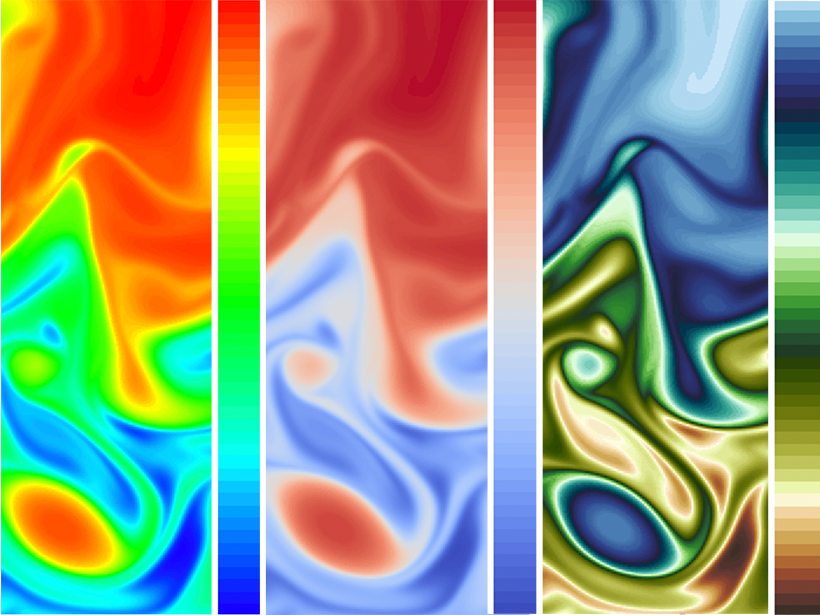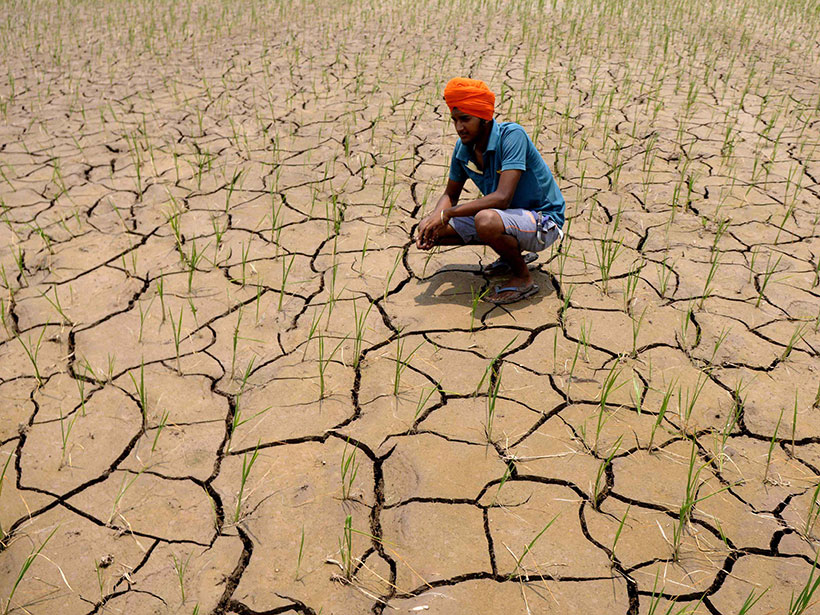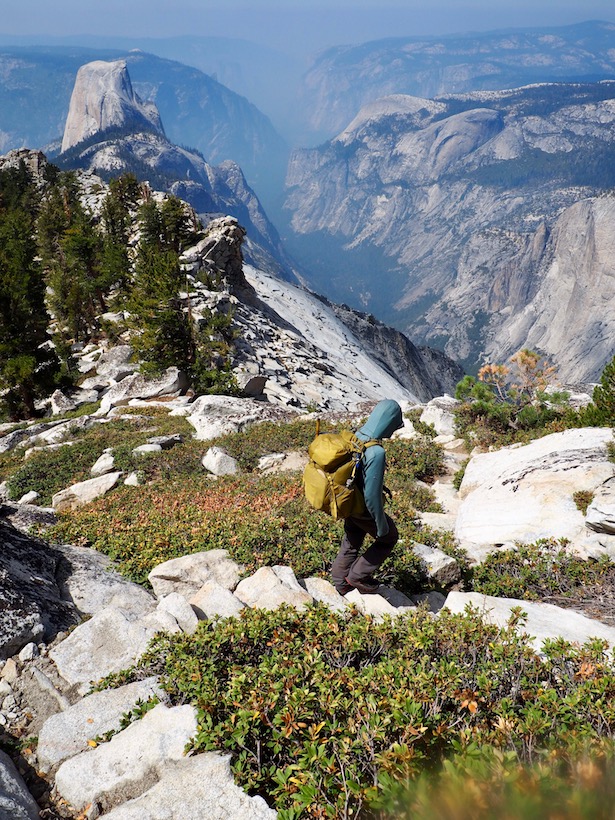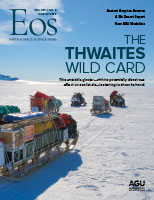What a year. The world endured a pandemic, civil unrest, and turbulent elections. At Eos, we kept on covering the geoscience news that taught us more and more about the natural world we live in. We welcomed our first Spanish translations, new international contributors, and a growing readership hungry for science news.
Our year-end roundup offers three takeaways:
- How we see science is important.
- Environmental justice is for everyone.
- We can’t wait to go back to the office.
We hope Eos was your trusted source of science news this year and you join us as we grow in 2021.
Best of 2020
“An Unfought Geoscience Battle in U.S. Prisons”: Kim Cartier displayed a deft and sensitive touch in bringing needed attention to the difficult and highly intersectional issues of health, safety, and equity in the U.S. prison system and in highlighting how efforts by those in the geoscience community can help create needed change.
—Timothy Oleson, Science Editor

I met Stephanie Zeller in February, on my last trip before the pandemic lockdown to the Ocean Sciences Meeting in San Diego. Stephanie was so passionate about her work on how to apply color to better interpret and analyze data and wanted to share it with her fellow scientists so they could get more out of their research. We spoke several times over that week about how to approach an article. Working closely with our science authors to present their work in Eos is my favorite part of this job, and it’s no surprise to me that “Visualizing Science: How Color Determines What We See” was in our top 10 most read articles of 2020.
—Heather Goss, Editor in Chief
There were so many gems in Eos this year. In my top two is a story about how climate change may severely affect coffee production in Ethiopia. With increasing temperatures, up to 59% of coffee growing environments in the country are at risk of being too dry to sustain coffee production, which is deeply concerning considering the vast impact Ethiopian coffee production has on labor and livelihood. The second of the two is the Third Pod from the Sun podcast with Leland Melvin. Not many people, or anyone actually, can say they were both drafted into the NFL and an astronaut. Listening to how an innocent curiosity morphed into an extraordinary career was a cheery and well-needed story to cap off 2020.
—Anaise Aristide, Production and Analytics Specialist
My favorite story that I wrote this year was about a science team that became stranded during the pandemic. It was in March when everything shut down, and I spoke with a researcher in the middle of the Atlantic Ocean trying to get home to Rhode Island. We talked over Skype while his boat sat outside a port in Cape Verde. The crew wasn’t sure if they’d be allowed in to resupply. Finding this story was serendipitous: I had looked through a schedule of the UNOLS fleet and found a ship still in transit. Hours later, I was talking with Rainer and following along on his journey. Our conversations really hit home with me: We were in the middle of an international crisis, and while many of us were battening down, scientists in the field were still trying to get home safe, while at the same time worrying about the world they were returning to.
—Jenessa Duncombe, Staff Writer
I appreciated the Thwaites issue. You think you know about climate change, but there is always some fresh horror. Big things are hard to comprehend. I knew the Antarctic was melting, but this story confronted me with the unstoppable acceleration of an immense catastrophe.
—Liza Lester, Staff Writer
One of my favorite stories this year was “An Unfought Geoscience Battle in U.S. Prisons” by Kim Cartier. This well-researched and detailed article shines a light on environmental issues faced by incarcerated people, a subgroup of the population often overlooked when it comes to having a voice at the table. From contaminated water so toxic that staff and guard dogs are given bottled water to drink to crumbling buildings prone to flooding, one is left to wonder how being incarcerated under such conditions is not considered cruel and unusual punishment, especially in one of the richest countries in the world.
—Tshawna Byerly, Copy Editor

I loved developing our small-but-mighty international cadre of writers. This story on desertification in Punjab, from Indian photojournalist Gurpreet Singh, is a standout—it’s a regional story that speaks to global issues, and the images are breathtaking.
—Caryl-Sue, Managing Editor
When I think back to what I wrote this year, the article that will always stand out in my mind is “An Unfought Geoscience Battle in U.S. Prisons.” Researching and writing this story taught me a lot about the unseen problems built in and perpetuated by the U.S. carceral system, and talking with the people who have been fighting these uphill battles for decades was both humbling and empowering. But more than that, this story reminded me that pressing science needs are found in unexpected places; that divorcing science and society is impossible; and, most importantly, that ally is a verb.
—Kimberly Cartier, Staff Writer
“Don’t @ Me: What Happened When Climate Skeptics Misused My Work” was an interesting case study in how groups with a political agenda can misuse and distort scientific studies, even when these studies are conducted well and presented accurately in the literature. The “lessons learned” section contained some useful suggestions on how journal publishers and academic institutions can support scientists in responding to misinformation campaigns.
—Nancy McGuire, Contract Editor

One of my favorite things that Eos publishes is the occasional series Living in Geologic Time by Mary Caperton Morton. The first of these “personal accounts that highlight the past, present, and future of famous landmarks on geologic timescales” was published at the end of 2019, and the series has come into its own this year. Morton writes in a conversational tone and makes geologic processes and their effects on humans accessible and engaging. I’ve enjoyed reading each article, and the web posts are also fun to make because each one is accompanied by great photos from the author’s trips. I hope that we can look forward to more in the year to come! (Next up, Cape Cod! —ed.)
—Faith Ishii, Production Manager
“Deepwater Horizon and the Rise of the Omics”: This feature superbly summarizes 10 years of research in environmental genomics and oil spill science that followed the 2010 Deepwater Horizon tragedy, demonstrating how substantial advances in our understanding of nature—and in our ability to mitigate effects of future disasters—can result from concerted (and well-funded) scientific efforts.
—Timothy Oleson, Science Editor
I loved this story on rice. The headline (“Will Rising Temperatures Make Rice Too Toxic?”) made me want to click immediately to find out more. It was just a great example of fantastic work that I have come to expect from Eos.
—Amy Storey, Vice President, Communications, Marketing, and Media Relations
being told that the summer session for my grad program might be cancelled 😣 might still be able to work on my advisors' project as an employee, but might not get the student health care– at a time I might need it most.
— jacob (@jacoparti) March 25, 2020
In the question of how teachers and students are handling academic disruptions this year, what about the people who are sort of both and sort of neither? Jenessa Duncombe’s excellent reporting throughout the year taught me how the COVID-19 pandemic has impacted some of science’s most vulnerable: early-career researchers.
—Kimberly Cartier, Staff Writer
“Visualizing Science: How Color Determines What We See”: The title says it all, and the illustrations drive the point home. The colors that scientists use to represent temperature gradients, eddy currents, and a host of other scientific information influence which features stand out, what gets buried in the detail, and how we interpret what the scientist is trying to present. Efforts to make it easier for scientists to use color more effectively should be a boon to scientific communications—once scientists are persuaded to start using these new tools.
—Nancy McGuire, Contract Editor
Lessons Learned
Inside Saturn, it rains helium.
—Kimberly Cartier, Staff Writer

One of the most interesting things I learned from Eos this year is how imaginative others are in interpreting scientific results so that they are more easily digested and understood by the public—and even that there is such a job as artist-in-residence at a pharmacy college! The article “Thinking Zinc: Mitigating Uranium Exposure on Navajo Land” by Ria Mazumdar discusses the important history of uranium mining on and near Navajo lands, what is (or, more accurately, is not) being done to clean up those sites, and the health ramifications for the local population. A fascinating aspect of the story highlights how Mallery Quetawki acts as a cultural liaison, visually interpreting the scientific findings through her art using familiar cultural concepts, such as depicting DNA as a string of turquoise beads.
—Tshawna Byerly, Copy Editor
Sciencewise…wow, I’m sure I learned something new from every piece I read. One takeaway that comes to mind quickly is just how significantly our interpretation of data and information can be influenced by color and combinations of color. It’s a point that makes sense intuitively I think, but it really sinks in when you see the same data presented side by side in different palettes.
—Timothy Oleson, Science Editor
I learned, once again, how important it is to make information more accessible. In 2020, Eos began translating several articles a month into Spanish, thanks to our great partnership with Planeteando. As our archive grows, we’re welcoming more and more readers in Spanish-speaking countries and offering more material to teachers who are looking for better translations from real geoscientists for students who speak English as a second language. I’m looking forward to finding more ways to offer more access to science news.
—Heather Goss, Editor in Chief
I spent my summer digging into the U.S. carceral system and the environmental problems found within. What I learned was heartbreaking.
It led to this article for @AGU_Eos, but there was so much more I didn’t have the space to include. A long thread:https://t.co/hgMsi5ffUl
— Dr. Kimberly Cartier (@AstroKimCartier) November 11, 2020
I learned that geoscientists can (and should!) become more involved in monitoring environmental conditions at U.S. prisons. Read why this geoscience battle is unfought in prisons in this Eos article by Kim Cartier and in her Twitter thread!
—Jenessa Duncombe, Staff Writer
I bookmarked these data visualization recommendations. The ideas around data vis aren’t really new, but the tools were new to me, and I want to check them out.
—Liza Lester, Staff Writer
I learned (or, rather, learned again) the value of Eos’s Science Advisers, who provided extremely helpful and timely feedback and who, on numerous occasions, pointed Eos staff toward intriguing topics and talented writers, advice that resulted in many excellent articles.
—Timothy Oleson, Science Editor
#FunFactFriday: Reindeer, musk oxen, bison, and horses may help save our precious permafrost. Graze on, gentle reader: https://t.co/3OzgaD6Wtn pic.twitter.com/2UblSyqSkR
— AGU's Eos (@AGU_Eos) March 27, 2020
—Caryl-Sue, Managing Editor
The Best Is Yet to Come: Eos in 2021
In 2021, I’m looking forward to the new administration’s climate agenda. Also, I can’t wait to just sit down with my Eos team members in person (once it’s safe for us to do so) and just chat about science news. Some of the best ideas we’ve had have come from roundtable discussions fueled by tea, coffee, and home-baked cookies.
—Kimberly Cartier, Staff Writer
I’m looking forward to the special issues we’re planning for next year. In January we’ll enjoy some “geomagnetic jerks” and “wobbly anomalies” for our theme on magnetic field research, while in February we’re going to take a serious look at how geoscience and the issue of food security intersect. We have a lot of fascinating science to look forward to in 2021.
—Heather Goss, Editor in Chief
Looking forward to an upcoming podcast episode about mental health for climate change warriors (or just the rest of us).
—Liza Lester, Staff Writer
I started working with Eos a little after the stay-at-home order was put into effect in D.C. My 7-month mark is quickly approaching, and though I love how seamless everything has been working from home, I am also anticipating the day I can meet everyone I’ve been working with in person. I have a little bit of FOMO hearing everyone talk about how amazing the AGU office is, so in 2021 I’d love to be able to check that out as well and experience our in-person workflow.
—Anaise Aristide, Production and Analytics Specialist
I am looking forward to Eos’s themed coverage in 2021, as we have a robust lineup of fascinating and intersectional topics we’ll be focusing on. Many of the articles in our theme packages, particularly those we are featuring early in the year, are well underway and are shaping up beautifully.
—Timothy Oleson, Science Editor
I’m looking forward to returning to the office! I miss my coworkers and the off-topic conversations we get into that often make me laugh. Getting tea with Kim Cartier and talking about our stories is one thing I miss the most about being in the office. Can’t wait for our team reunion.
—Jenessa Duncombe, Staff Writer
New Orleans (and AGU 2021) awaits! Just one muddy step away from my Eos dream theme of “deltas, marshes, swamps, mires, bogs, estuaries, and other brackish wetlands”!
—Caryl-Sue, Managing Editor







